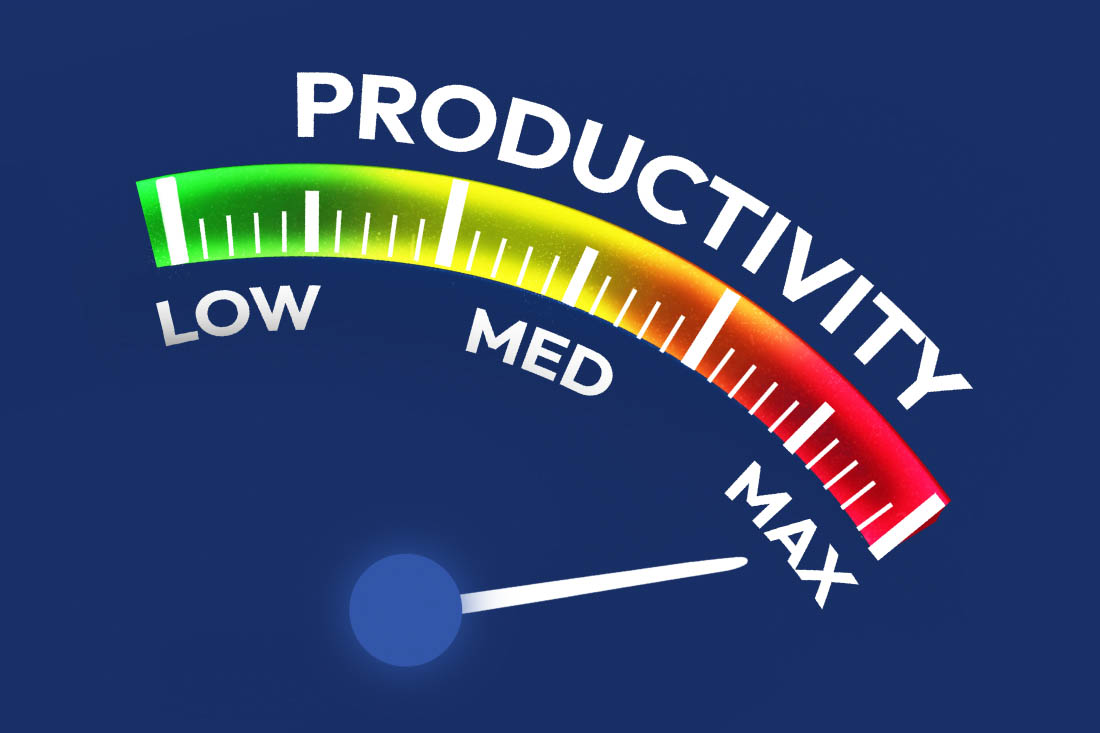How much more could your organization achieve by eliminating distractions, improving work-life balance and opening the door to more flexible work?
Based on decades of definitive research, the answer is “a lot.”
These are all examples of strategies successful business leaders use to maximize employee productivity. They help people get more done in less time, resulting in all kinds of bottom-line improvements for the business. In fact, one expert estimates the most productive companies experience 30-50% higher operating margins than industry peers.
Maximizing employee productivity can be challenging, but the payoff is enormous. To help, let’s look at ten strategies to help you get there.
1. Use productivity management software
Before you can take steps to boost productivity, you have to set benchmarks. But anyone who’s attempted to measure workforce productivity knows how complicated the process can be. The productivity formula is complicated and time-consuming. And while it might paint a basic picture of overall productivity, it won’t give you insights into individuals or teams.
To help employees work as productively as possible, productivity management software is key. It collects and analyzes daily activity data for you, then turns that information into insights. The result is a quick-reference snapshot of how, when and where people are most productive.
2. Give people permission to focus
The amount of time most employees spend on unproductive activities is mind-blowing. In an average eight-hour workday, most people are productive for just two hours and 53 minutes. The rest of the time goes to messaging apps, chatting with colleagues, checking social media and making food or coffee. Granted, not all of these activities are time wasters. And taking breaks is important for maintaining energy. But there is a way to help people double or even triple their productive time.
The key is to set the stage for focused work. These dedicated blocks of time allow employees to concentrate on one important task or project without interruption. No phone calls. No pings. No hopping on a quick video chat.
Many people accomplish far more in a single hour of focus time than in three or four hours filled with constant distractions. But they need your support. Give employees permission to block calendars, turn off notifications and silence phones when there’s important work to do. As long as they let team members know when they’ll be unavailable, this strategy is highly effective.
3. Nix unnecessary meetings
Not all meetings are bad, and many are vital for setting goals and expectations. But do you really need to hear everyone’s status update again? Have people stopped paying attention during your weekly syncs? These ineffective meetings disrupt workflows, take up valuable time and cause frustration among otherwise engaged employees. And at most organizations, nearly one-third of all meetings are unnecessary.
Cutting back on meeting time is a great way to maximize productivity, and it’s relatively easy to do. Focus on reducing meetings to only the essential ones. Not sure what’s essential? If you can achieve the same communication in an email or shared doc, do that instead. That way, each team member contributes when it works best for them — no more interrupting an otherwise productive block of focus time just because another meeting reminder popped up.
4. Always set realistic goals
Of all the activities that energize employees, making daily progress on meaningful work is the most important. But when team members chase unrealistic goals, it’s impossible to experience that sense of accomplishment. Instead of boosting motivation, the result is more stress and lower performance.
Thankfully, the solution is simple. Any time you create a timeline or ask for a new deliverable, ask the question: “Is this realistic?” This one question gives employees the freedom to collaborate with you on setting achievable goals. Rather than burning out to meet impossible deadlines, they work toward meaningful, manageable goals that help add purpose and passion to their workdays.
5. Refine work environments
At many organizations, remote work means you no longer have a say in how individual workspaces are set up. But employees still need productive environments, no matter where or when they work. Something as simple as a second monitor can boost productivity by 42%.
While you don’t have control of home offices, you can take steps to support productivity. Some companies provide a one-time or recurring annual stipend to set up home offices as employees see fit. Others offer options for purchasing productivity-boosting equipment, such as noise-canceling headphones and external monitors. How you approach the work environment is up to you; just be sure to ask employees for input on what they feel they need to be productive.
6. Be open to flexible work arrangements
Do your employees work at set, specific times? Depending on your industry and business model, this may be a disadvantage. The reason: According to behavioral economists, most people have a two-hour window when they’re most productive — usually in the morning. But what if that time goes to a morning commute, followed by an hour-long meeting? By the time your employees finally sit down to get work done, it’s much harder to focus. Throw in the temptation of group chats or conversations with nearby colleagues, and concentrating becomes downright impossible.
Instead, talk to employees to see if a flexible arrangement would help. For example, many organizations use flextime to let employees choose their start and end times. This arrangement recognizes that different people have different peak productivity times, and allows employees to work when they’re most efficient. Or you could try a hybrid model that allows team members to work from home when they need to focus. Better yet, use ActivTrak’s Location Insights feature to see where employees are most productive and build your model accordingly.
7. Actively promote work-life balance
Employees can’t give you their all if they’re always working. In fact, research shows that continually working more than 40 hours a week is “useless.” Consistently overworking causes energy levels to plummet and eventually leads to burnout.
If you want employees to be as productive as possible, encourage them to rest. Sure, it’s important to work hard. But people also need to feel comfortable taking vacation time, enjoying activities outside work and powering down the laptop to get a good night’s sleep. While you can’t give people work-life balance, you can encourage it. Providing company-wide wellness days, being generous when approving paid time off and setting an example with your own schedule are all great ways to do this.
8. Help employees monitor their own productivity trends
There’s no “on” switch for productivity — either it happens, or it doesn’t. And unfortunately, a quick trip to the coffee shop rarely turns around an otherwise sluggish day. For this reason, it’s important to understand the times of day when employees are most energized and engaged.
One easy way to do this? Give your employees access to ActivTrak’s Personal Insights dashboards. Many of the most successful workers use these personal productivity metrics to discover the best times for focused work and build healthier work habits.
9. Take care of your people
According to Gallup, organizations lose an astounding $322 billion a year to lost productivity caused by burnout. But take care of your employees, and productivity is bound to bounce back.
The key is to monitor well-being on an ongoing basis. Whether you conduct surveys or use employee engagement software, find out what your people need to thrive — and then look for ways to provide it. You might be surprised to see what the data reveals! For example, one organization wondered if employees were actually working, but in reality, found some people were working more than 12 hours a day. It turns out that employees were spending a lot of time on manual processes in Excel or in extra meetings. By figuring out what was going on, the company identified ways to improve efficiency and recognized they also needed to hire more people to avoid burnout.
10. Trim your tech stack
Can you have too much of a good thing in the workplace? When it comes to technology, the answer is “yes.” Nearly 60% of office workers say they’re stressed about the number of tools they have to use. Even more are overwhelmed by the number of new technologies they have to learn. While many tools improve productivity by automating manual tasks or simplifying workflows, you only need so many. After all, one comprehensive project management app does the job — no need to subscribe to five more.
So, how do you decide what to cut? One option is to implement a SaaS spend management plan to audit, monitor and adjust your tech stack. Even better, leverage ActivTrak’s tech usage reports to see what technology your teams actually use — and what they don’t.
Maximize employee productivity with ActivTrak
The sooner you help employees maximize productivity in the workplace, the better. The strategies above aren’t random — we’ve witnessed the results they produce countless times at thousands of organizations.
However, there’s one more overarching strategy that’ll make the entire process work faster: Measure productivity.
ActivTrak’s productivity management software tracks key trends across your workforce. The dashboards are so helpful, more than 9,500 organizations rely on them to understand where, when and how people work best.
Sound like something you could use? Schedule a demo and we’ll be happy to show you how it works.





